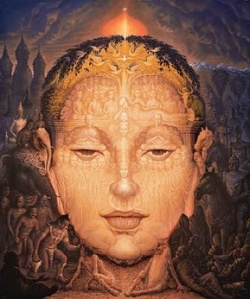Ten stages of the mind
A system of comparative classification formulated by Kobo(774-835), the founder of the Japanese True Word (Shingon) school. He explained it fully in The Treatise on the Ten Stages of the Mind and summarized it in The Precious Key to the Secret Treasury. On the basis of the "Stage of the Mind" chapter of the Mahavairochana Sutra and The Treatise on the Mind Aspiring for Enlightenment by Nagarjuna, he classified Buddhist and non-Buddhist teachings according to ten stages in the development of religious consciousness. He then placed practitioners of the esoteric teachings of the True Word school in the highest, or tenth, stage. Kobo described the ten stages as follows:
(1) The stage of the human animal, in which one is governed, like an animal, by instincts and passions. This first stage he termed the "mind of lowly man, goatish in its desire."
(2) The stage of moral awareness, in which one practices secular virtues. This stage corresponds to Confucianism with its emphasis on moral order, which makes self control possible but nevertheless is limited to this world.
(3) The stage of dawning religious aspiration, in which one relies on supernatural beings and practices in expectation of a heaven beyond this world, thus gaining temporary respite from worldly anxieties. This stage corresponds to Brahmanism and Taoism.
(4) The stage of the denial of the ego, in which one sees that only the five components of life are real and that there is no permanent self, thus divesting oneself of the concept of an unchanging ego such as the atman of Brahmanism. Voice-hearers are in this stage.
(5) The stage in which one strives to rid oneself of illusions and evil karma by perceiving the twelve-linked chain of causation. Cause-awakened ones belong to this stage. Stages four and five correspond to Hinayana Buddhism.
(6) The stage of the bodhisattva mind, in which one arouses non-discriminating compassion for all beings and realizes that the mind alone exists. This stage corresponds to the Dharma Characteristics ( Jpn Hosso) school, which is regarded as an early stage of the Mahayana teachings.
(7) The stage in which one understands the eight negations and is enlightened to the nonsubstantiality of both mind and material objects. This stage corresponds to the teachings of the Three Treatises (Sanron) school.
(8) The stage in which one realizes the essential oneness of the phenomenal world and the ultimate reality and embraces the one Buddha vehicle. This stage corresponds to the Tendai school.
(9) The stage in which one realizes that there is no fixed identity or self-nature within the ultimate truth. This stage corresponds to the Flower Garland (Kegon) school. Stages six, seven, eight, and nine indicate the realm of the Mahayana bodhisattva.
(10) The stage of realization of the esoteric truth, i.e., Buddhahood.
Kobo equated this last stage, which he termed the "glorious mind, the most secret and sacred," with Buddhahood, and he correlated it with the True Word school. With these ten stages, Kobo ranked the teachings of the Flower Garland and True Word schools above the Tendai school, which is based on the Lotus Sutra.
